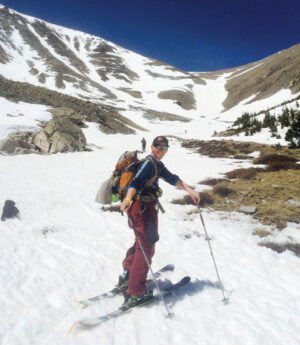By Hal Walter
It started when Harrison was in sixth grade and the coach suggested he go out for the middle school cross-country team. I’d never considered that Harrison would be on a school sports team, but when he said he wanted to do this, I was all in.
I’d also never considered this would lead me to a new avocation.
As those first after-school practices wore on, it became clear that I would need to be around in case Harrison had an autistic meltdown. Before the season was out, Coach Jack Swartz was referring to me as “Coach Hal,” and I was starting to guide the other kids as well as Harrison during practices and meets, and even substituted as assistant coach for one meet.
When track season rolled around the following spring, practice was part of the middle school PE program, but it was clear I would need to accompany Harrison to competitions. I still remember that first track meet in Mosca when I drove nearly three hours not knowing if he would have the focus to stay in his lane and run around the track even once in the 400-meter dash.
The years went by like a blur. Harrison’s nickname became “The Blur.” Coach Swartz left for a job in the Denver Metro area. Coach Jesse Taylor took his place as the school’s distance coach. The “Coach Hal” nickname stuck, and I started to really like it.
[InContentAdTwo]
Both coaches Swartz and Taylor were amazing talents and teachers. Coach Swartz ran four years of track and cross country at Plattsburg State in upstate New York, specializing in steeplechase. Coach Taylor had been an All-American also in steeplechase at running powerhouse Adams State University in Alamosa.
As a volunteer coach, I had a lot to learn from these guys. Although I’d found my own way through 38 years of self-coached running, I had no formal background in cross-country or track. My “specialty” was pack-burro racing – even more obscure than steeplechase – though I’d won local running races at distances including 1 mile, 5K, 10K and the marathon.
It was inevitable that Coach Taylor would leave. He had been studying at the Sangre de Cristo Seminary with the intention of becoming a minister. With no opportunity locally to support his family, he took a job with a church in South Dakota. Suddenly there was an opening for a coach, and I was a likely candidate. I began having conversations with Joy Parrish, the school’s athletic direction and head track coach. The next thing I knew I was taking online classes in preparation for being the high-school distance coach for the upcoming spring track season. Through my work with Dr. Phil Maffetone, I’d also become an MAF founding coach.
Coach Taylor’s departure also meant his son Jeremiah, a standout distance runner, moved, too. Subsequently our top boy runner, a state contender, also moved, and we lost other track athletes to the upstart baseball program.
When the first day of practice rolled around in February, Harrison was the only distance runner to turn out for the small team that also included sprinters, jumpers and throwers. I’d also be coaching his classmate Kyleigh, a 400-meter runner, but she had declared herself a dual-sport athlete in baseball and would only be working out with us once or twice per week. A sprinter, Alyssa, also would be running with us occasionally to build endurance for the 200-meter dash.
Our dirt track was virtually unrunnable, a quarter-mile oval of wind-swept ice, drifted snow and mud. I improvised with workouts on the pavement in Westcliffe, running straight-aways, and using street blocks as a makeshift track. With two weeks of practice behind us, the Pueblo Early Bird meet loomed and none of the kids had even set foot on a proper track. I signed Harrison up for four distance events – the 1600, 400, 800 and 3200 – figuring he had no chance of placing but could gain from the experience.
This first meet arrived with a fierce gale. Early on, the wind blew another team’s metal-framed canopy tent tumbling right over our team seated on the bleachers. Miraculously, nobody was injured. We bundled up and waited for the distance events all set for later.
At last it was time for Harrison’s first run of his varsity track career – the 1600 or “mile.” He was hanging with the mid-pack when the stomach bug hit. He dropped back and finished strong but was soon on the turf wrapped in a blanket and writhing with stomach cramps as Kyleigh was warming up for her 400. She is a natural at this distance and placed 3rd.
Harrison was still in pain but wanting to run the 400. He got a good start, then faded. Since Mary had come to watch, he was able to go home with his mom, who later called to report he had a 101-degree fever and was concerned he had let his teammates down. She assured him he had not, and I would later reinforce this.
• • •
Each day at practice, our athletes do something they call a “prompt.” Essentially, it’s a commentary on everyone on the team and also the coaches. For example one day it was, what would your new hairstyle be? And mine was a “bright orange Mohawk with traffic cone spikes.” Another day it was what would you do if you won the lottery? And they went down the list of everything everyone on the team would do with their riches and lastly when they got to me they said: “Coach Hal would give it all to charities.” I was stunned by the most heart-warming compliment I’ve ever been given.
• • •
Next up was the Harrison Invitational in Colorado Springs. The Blur was excited to run at a school with his name, and I once again entered him in all four distance events.
Early in the meet, Alyssa fell in the 100-meter dash and broke her arm badly. I was not right there when it happened and heard about it from one of the other kids who found me and said Coach Parrish was with Alyssa. When I located them, Joy was literally frozen in place holding Alyssa’s arm together with both hands and elevating it along with an ice pack.
I fished Joy’s phone out of her jacket and started the process of contacting Alyssa’s parents. The meet’s athletic trainer showed up with an arm splint. Soon Alyssa and Joy were in another parent’s vehicle and on the way to a nearby emergency clinic. Joy called later to tell me they were transferring to Memorial Hospital for surgery. I scrambled to keep track of the sprinters and jumpers in Joy’s absence, and also get Harrison ready for his events.
With all this chaos going on, Harrison ran all four of his races – a total of 3.75 miles of track racing – flawlessly, finding his stride as a freshman competing with a lot of bigger kids from much bigger 4A and 5A schools. Though he finished last in each event I was proud of how he hung in there and did his best, running strong in each event.
The meet complete, we loaded up the team bus and swung by the hospital to retrieve Joy on our way to a restaurant and then on home. My fitness tracker indicated I’d covered 7.7 miles there in the stadium that day. My sense of accomplishment told me I’d traveled much farther.
Hal Walter is the author of “Endurance and Selected Essays on Autism, Neurodiversity and Deep Sport,” available at the Book Haven in Salida and online at amazon.com.


